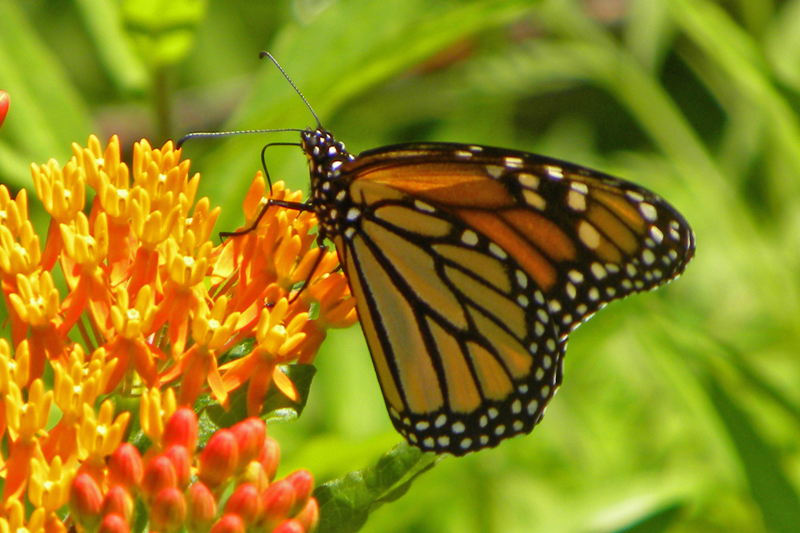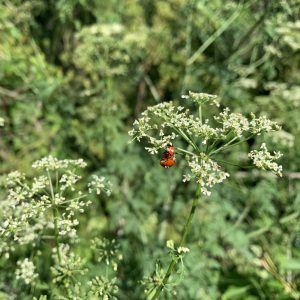 Each fall, hundreds of millions of monarch butterflies migrate from the United States and Canada to overwintering areas in Mexico and California where they wait out the winter until conditions favor a return flight in the spring. The monarch migration is truly one of the world’s greatest natural wonders, yet it is threatened by habitat loss in North America – at the overwintering sites and throughout the spring and summer breeding range as well. Just think – how many Monarchs have you seen in the last few years? Far less than 5 or 10 years ago.
Each fall, hundreds of millions of monarch butterflies migrate from the United States and Canada to overwintering areas in Mexico and California where they wait out the winter until conditions favor a return flight in the spring. The monarch migration is truly one of the world’s greatest natural wonders, yet it is threatened by habitat loss in North America – at the overwintering sites and throughout the spring and summer breeding range as well. Just think – how many Monarchs have you seen in the last few years? Far less than 5 or 10 years ago.
Monarch Waystations are places that provide resources necessary for monarchs to produce successive generations and sustain their migration. Without milkweeds throughout their spring and summer breeding areas in North America, monarchs would not be able to produce the successive generations that culminate in the migration each fall. Similarly, without nectar from flowers these fall migratory monarch butterflies would be unable to make their long journey to overwintering grounds in Mexico. The need for host plants for larvae and energy sources for adults applies to all monarch and butterfly populations around the world. Creasey Mahan Nature Preserve is now a certified Monarch Waystation!
 We are concerned because milkweeds and nectar sources are declining due to development and the widespread use of herbicides in croplands, pastures and roadsides. Because 90% of all milkweed/monarch habitats occur within the agricultural landscape, farm practices have the potential to strongly influence monarch populations. Many other kinds of butterflies are in decline and will benefit from planting of native wildflowers as well.
We are concerned because milkweeds and nectar sources are declining due to development and the widespread use of herbicides in croplands, pastures and roadsides. Because 90% of all milkweed/monarch habitats occur within the agricultural landscape, farm practices have the potential to strongly influence monarch populations. Many other kinds of butterflies are in decline and will benefit from planting of native wildflowers as well.
Development. Development (subdivisions, factories, shopping centers, etc.) in the U.S. is consuming habitats for monarchs and other wildlife at a rate of 6,000 acres per day – that’s 2.2 million acres each year, the area of Delaware and Rhode Island combined!
Genetically Modified Crops. Widespread adoption of herbicide-resistant corn and soybeans has resulted in the loss of more than 80 million acres of monarch habitat in recent years. The planting of these crops genetically modified to resist the non-selective systemic herbicide glyphosate (Roundup®) allows growers to spray fields with this herbicide instead of tilling to control weeds. Milkweeds survive tilling but not the repeated use of glyphosate. This habitat loss is significant since these croplands represent more than 30% of the summer breeding area for monarchs.
Roadside Management. The use of herbicides and frequent mowing along roadsides has converted much of this habitat to grasslands – a habitat generally lacking in food and shelter for wildlife. Although some states have started to increase the diversity of plantings along roadsides, including milkweeds, these programs are small.
Unfortunately, the remaining milkweed habitats in pastures, hayfields, edges of forests, grasslands, native prairies, and urban areas are not sufficient to sustain the large monarch populations seen in the 1990s. Monarchs need our help.
You can help! To offset the loss of milkweeds and nectar sources we need to create, conserve, and protect milkweed/monarch habitats. We need you to help us and help monarchs by creating “Monarch Waystations” (monarch habitats) in home gardens, at schools, businesses, parks, zoos, nature centers, along roadsides, and on other unused plots of land. Without a major effort to restore milkweeds to as many locations as possible, the monarch population is certain to decline to extremely low levels. By creating and maintaining a Monarch Waystation you are contributing to monarch conservation, an effort that will help assure the preservation of the species and the continuation of the spectacular monarch migration phenomenon.


